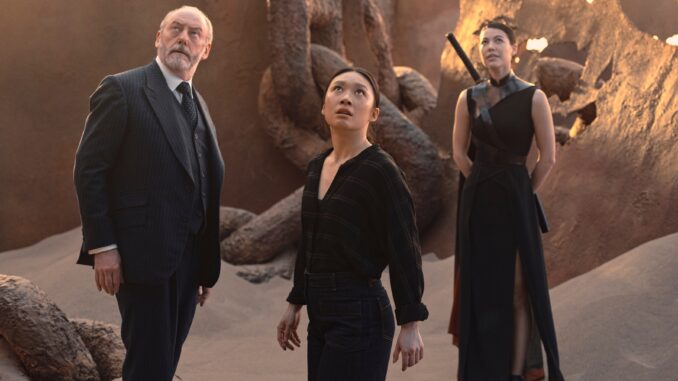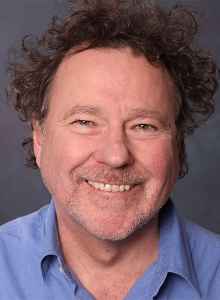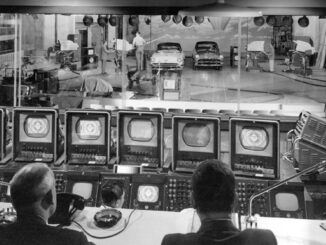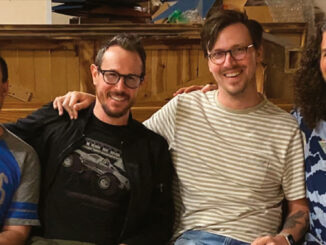
By Kristin Marguerite Doidge
The human element of the hit Netflix sci-fi thriller, “3 Body Problem,” is what helped audiences connect to its gripping and often highly technical material. It’s also what has helped Emmy-nominated picture editor Michael Ruscio, ACE, to be successful in a craft that has grappled with its own technical and technological changes over the past three decades.
Showrunners David Benioff, D.B. Weiss, and Alexander Woo began work on the series in 2019. Having come off the global success of “Game of Thrones,” Benioff and Weiss became interested in creating a project that was decidedly different and challenging in new ways. Ruscio’s previous work with Woo on “True Blood” led to the opportunity to join the post-production team in June of 2022 (alongside fellow editor Anna Hauger) when it became clear the project needed four editors.
The show’s title comes from the 2008 novel “Three-Body Problem” by Chinese science fiction author Liu Cixin, as well as the physics principle of the same name: when three celestial objects (planets, stars, or suns) with similar mass are in close proximity – and therefore exerting force on each other – creating a “three-body problem,” whereas normally when two objects exert force on each other, it’s easier to predict the objects’ rotation.
The series is focused on how a young woman’s fateful decision in 1960s China reverberates across space and time into the present day. Alongside the more epic elements of the story — vast and sweeping environments set in a virtual reality world, the threat of alien invaders (known as the San-Ti), an ominous countdown that can inexplicably overtake a person’s vision — was a simple, grounded core narrative: when the laws of the universe start to break, a group of five brilliant, close-knit college friends (a.k.a. the “Oxford Five”), must reunite and figure out who’s responsible before time runs out.
The diverse set of characters in the show mirrored the sensibilities of those behind the camera, Ruscio said.
“I think the three showrunners are each really different,” he added. “The [trilogy of Cixin’s] books are really scientific, and they adapted the first book so that they had this human element. They invented the ‘Oxford Five,’ and so right away, we knew that the show had to be accessible and not ridiculously science-based.”

That balancing act of both the human and scientific elements was perhaps best displayed in the first season’s epic Episode Five, “Judgment Day,” for which Ruscio is nominated for a Primetime Emmy Award. As chaos ensues during a top secret mission that puts humanity’s global civilization in danger, the humans must act decisively and swiftly to survive as the aliens announce their presence to the whole world with a single chilling gesture – a supertanker ship carved up into slices, along with its passengers by a Sophon.
With the Sophon (a tiny proton-sized supercomputer invented by the show’s alien race, the San-Ti) sequence, Ruscio said everything was explained on the page. Still, collaboration with the sound design and VFX teams became critical to capturing the story effectively.
“Everything is described: this proton splits and this becomes one,” he said. “We went through various VFX passes where we had designed certain shots and realized, you know what? We don’t really need that. We just need the tail end. And so we were always going back and forth working closely with VFX. That, I think, was very unique to me as far as how intimate that collaboration was.”
Back in his early days as an assistant editor, Ruscio explained that while assisting Dennis Virkler on the submarine spy thriller, “The Hunt For Red October” (1990), they were using Lucas’ ILM shots for the submarine, boats, and everything else. Today’s collaboration was happening so much more rapidly and in real time.
“Fellow assistant editor John Haggar and I would go back and forth to ILM and basically have the shots put in,” he said. “In this case on ‘3 Body Problem,’ though, we were on the ground – we had weekly VFX meetings, and it would be a situation where sometimes I would guide them with VFX, the chyrons, and then they would sometimes guide me. We’d have this shot in progress and I’d want the most updated shots inserted into the cut. Sometimes they might talk to the producers separately, and I needed to have sort of an agency over it to keep the helm of the [actual and proverbial] ship – to keep it functioning as current as possible. Current cut became not just a phrase.”
Solving the problem
Ruscio began his editing career making films with independent mavericks Alan Rudolph and Robert Altman. He has enjoyed editing some of the top dramatic shows of the past 20 years, including “The Sopranos” and “House of Cards,” as well as “The Leftovers” and “Six Feet Under,” which he worked on with his late friend and colleague, editor Sue Blainey.
The first season of “3 Body Problem” received acclaim from both audiences and critics alike. Netflix recently announced a second and third season will be forthcoming, and Ruscio hopes to rejoin the talented team of storytellers to continue the saga together in the cutting room.
In the meantime, he’s focused on continuing to mentor the next generation of editors both formally and informally (he created a workshop for the American Film Institute on the art of editing, which he also taught at the Los Angeles Film School). His advice for emerging editors is to immerse themselves in the process – and, importantly, to always find a way.
“It’s like the improv thing where you say, ‘yes, and…’: I’m that way with editing now,” he explained. “And I’ve taught this idea to my assistants. Sometimes when they start out they say, ‘Well, we don’t really have that’ or ‘I can’t really do this.,’ but I tell them: we have to figure out a way to make that story be told in this way. Your facility as an editor is to be able to say, ‘Okay, well what if I steal this shot?’ or ‘Maybe if I do this, or even if I reverse it,’ or ‘What are all the tools I have in the bag? How can I express that vision and still make it have some kind of editorial and architectural integrity, and keep both of those afloat?’”
It’s no easy task, he said, but can be incredibly rewarding when it works.
So what’s the way through in a creative world increasingly impacted by outside forces such as AI? “Find editors who will actually mentor you,” Ruscio said. “Some will, and some just have a different philosophy about that; so align yourself with people who will help you with your goals. Do whatever you can to learn and grow – and to always find a way.”





